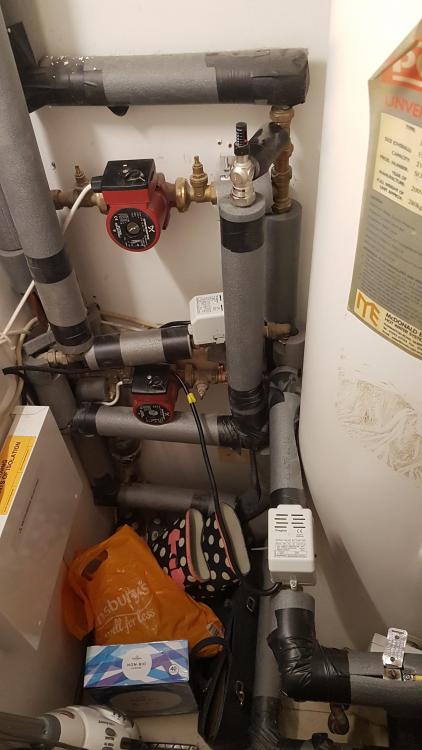Search the Community
Showing results for tags 'hot water'.
-
I’m after some advice or suggestions as to what to look into. I’ve been working on a small 1-bed refurbishment project in the Outer Hebrides. I have one source of energy for the building which is electricity. So for the heating aspect, I think I’ll have things covered with two stand-alone electric radiators and a wood burner. What I’m unsure of is the best option to provide hot water? Realistically I just need hot water over a kitchen sink, and in the bathroom, I was looking at an electric shower and again, a hot water tap for the basin. What would be my best options to achieve this?
-
Hi Just wondering if repairs done by British Gas to my combi boiler come with a guarantee? Had it serviced under contract and some parts replaced 4 weeks ago but gradually the old problem of no hot water downstairs has returned. We were told at the time it was probably a diverter valve problem which the engineer replaced. Central heating upstairs and downstairs is fine but sink and shower hot water has recently become very slow to heat and often goes cold after a minute or two. The system pressure is down to below the safe minimum level today so we had to turn it off. I haven't noticed any leaks anywhere. A British Gas engineer is booked to come tomorrow and as there's an excess to pay on repairs with our service cover I'm wondering if it's likely that they will waive it because of the previous repairs not having been successful? All thoughts welcome. Thanks David
-
I am in the process of buying a house. Given kwh cost of electricity - I am hoping to swap out the direct unvented hot water cylinder (in the landing airing cupboard) with a direct equivalent. Underfloor heating manifolds are in the same cupboard. Boiler (feeding underfloor heating) is in the attic. Assuming given presence of a boiler this is possible? Any foreseeable issues and an idea of expected costs would be much appreciated.
- 4 replies
-
- boiler
- unvented cylinder
-
(and 2 more)
Tagged with:
-
Suggestions please on the best/most economic way to provide hot water and heating without using gas in the following situation: A 7m x 7m x 2.4m, well insulated, temporary accommodation for us while we build (max 1 year hopefully), which will ultimately be used intermittently as part craft workshop/part gym. size (approx 7m x 7m) which will ultimately be split into two rooms Walls are concrete block dry lined with 100mm insulation and OSB board Floating floor - 50mm insulation & board, insulated ceiling There will be a simple MVHR system in place to provide ventilation Living area ( to become a craft room), bedroom, shower room, small office (to become gym/workshop) Living area will have a log burning stove in 12kw solar panels on the roof ( for use with house also ultimately) Eventual use will require hot water - preferably instantaneous, as it will be used occasionally and often for shortish periods . Heat from the log burner in the craft workshop will be sufficient.
-
Running all 4 in the winter is quite interesting: PV generation: About a week with overcast skies and then a couple of days of sun. January is supposed to be the low point for PV generation. Based on the EU calculator we should produce about 180kWh in January. We measured 195 which is about 6.3kWh a day on average. However generation happened spasmodically along with the weather. For example 14kWh on a good day and 0.86kWh on a poor day. EV Having the electric car meant that on the few days in the month when the PV generation was over 2kW we charged the car. We use a 3kWh plug in charger. Even with a 5.12kW system on the roof at peak generation during January we only saw a top of about 3kW, so rather than waste (send to the grid) maybe a kW or two we charge the car when generating 2kW or more and reduce the overall cost of charging the car. We calculate that over a ten year period that 1kWh used will have cost us about 10p. Hot water: Most of the excess was captured in the hot water tank using the Solic 200 controller and a 1kW twenty seven inch immersion. Twice even reaching over 60C resetting the countdown timer designed to warn us when the tank has not been over 60C for more than 10 days. MVHR The MVHR is now running smoothly with all controls working. One of the interesting items is the water coils that have been installed in the air ducts. These have increased the inlet air temperature from 17C up to 25C depending on the heating water set temperature and flow rate through the coils. Quite nice to have warmer air into the rooms in winter. Can't wait to use them in summer when cooling the bungalow using the ASHP and powering the ASHP using the PV. ASHP: ASHP kWh use over January roughly 9kWh a day for 100m2 for average 20 C over 24 hours indoor temperature. Had to move the ambient temperature sensor on the ASHP the other day because it was exposed to direct sunlight and effecting the temperature compensating mode. If it wasn't for Build Hub and the helpful contributors I would have struggled with half of this..... Thanks to everyone on here who helps. Many people who are new to the idea of ASHPs will find this a good place to start. Good luck with your project. M
-
While tinkering with the flow meters on my ground floor UFH manifold today the hot water came on. I've heard of hot water priority and I think this is how my system is set up. I noticed, however, that the manifold pump was still running, the actuators were all energised but the flow meters all showed no flow. At this point the manifold pressure was higher than normal too. This seems wrong to me as the pump is working but unable to circulate water through the system as the heating zone valve is closed (as it should be in). The micro switch on the heating zone valve seems to be working as the pumps in the heating and hot water tank cupboard come on when it energises - as an additional point i'm curious about, there are two red Grundfos pumps in that cupboard and they both come on when the hot water or heating are on - is this correct? I've always assumed that one was for the hot water system (indirect unvented cylinder heated by ASHP) and the other for the heating (all UFH heated by ASHP) but maybe they are meant to be on at the same time? Perhaps one is a send pump, one a return pump? I've attached a photo in case anyone is kind enough to take a look. So, in summary should the UFH manifold pump and actuators be de-energised if the heating zone valve is closed due to the hot water priority? And should both grundfos pumps be running at the same time when the hot water or heating are running? Thanks for any help anyone can give me.
- 3 replies
-
- underfloor heating
- heating system
-
(and 1 more)
Tagged with:
-
Hi Guys, General questions about the best way to heat water in a small cottage with two people. I am looking for the best way i.e. cheapest, to heat water in our small cottage with just myself and my Wife and only three hot water taps. Should we heat a Hot Water Tank or would an instantaneous water heater be a better option. We are electric only no oil or gas. Many thanks.
-
If the bathroom is a long way away from hot-water source, I recall a post where @PeterW suggested connecting the hot pipe also to the WC cistern so that flushing the toilet would pull through the dead-leg of cold water in the pipe. (I searched but could not find the old post.) Is this still considered a good idea? My bathroom will be about 15m from the hot-water source (a Sunamp).
-
I'm trying to shut off the hot water supply to repair the kitchen tap. Unfortunately I can't see any isolator valves near the tap, so I'm puzzling over how to shut off hot water for the whole house. I tried to do a bit of research into how our heating & hot water system works, but I may be getting this wrong, and to be honest I'm kind of tempted to just post the question "What the heck do all these pipes do?", but I shall try to be more specific. It's an F&E system with two tanks in the loft and hot water cylinder in the first floor airing cupboard, which looks like this: So according to these instructions I need to close a valve which feeds cold water into the bottom of the cylinder. "This valve should be easily recognisible as a valve with a red, wheel-shaped handle on a pipe that runs from the ceiling of the airing cupboard to the bottom of the cylinder." The valve in the top-right (just above the top shelf) seemed to fit that description, so I tried closing that. Then I noticed the valve in the bottom left could also fit that description, so I've tried closing that too (although I may be misunderstanding the direction of flow there) I notice there's three pipes leading into the bottom of the cylinder. The third one slightly higher on the left is hopefully shut off by the motorised valve (I have the heating and hot water switched off) I then try running the hot tap for a minute or two, but it's showing no signs of stopping. Do I just need to wait longer for pipes to drain out? I tried the same on the 2nd floor bathroom because I thought it might stop flowing quicker there, but ...no sign of stopping.
-
Hi everyone, a quick intro to say hello. More a renovator than a self builder and very much at the end of a project to make an 1870s Bristol house suitable to keep us here for at least the next ten years with a growing family. With a 2 year old and a now a two week old I had as an objective to reduce the carbon footprint of our energy use. The project was principally a single story extension to make a kitchen diner in addition to various changes to other rooms such as a bathroom with some walls coming out in the process. The opportunity was there to move the boiler and having had one too many showers turn cold with another tap being used, I decided it was worth doing something to the water system in toto. This is where I owe this forum and certain contributors a huge thank you as I learnt a great deal from them whilst trying to decide where to go with the spec although it didn't quite follow the original plan. The house is a narrow terrace with a couple of rooms on each of three floors and is topped off with a butterfly roof so less than ideal for solar. So why join the forum now? Well the principle threads I followed were around hot water and we've ended up with a 4kw array on the more favourable pitch, a Powerwall 2, and a Mixergy tank. This last part I see mentioned here quite a bit so wanted to offer a bit of user feedback to those considering one if that might be useful. There was much to'ing and fro'ing before arriving at this setup and the original intent had been a Sunamp Uniq 9 or larger. Various things conspired to drive the spec as it stands and we're only in the first few months of use. Very much learning as we go. I hope this finds everyone well in these times. Best, Billy
-
Hello all, I stumbled on this forum as part of a search for information about SunAmp batteries. I’ve spent a bit of time reading other threads on the topic and this seems to be a friendly and helpful piece of the internet. I’m on a quest to reduce the CO2 generated by the 3-bed 1960s semi (approx 98 sq m) where I live with my partner (no kids). We’ve insulated the upstairs, added some loft insulation, upgraded the double glazing and last year, we installed 5700W of solar panels and a Tesla Powerwall 2. I’d estimate we generate around 5000kWh a year from the panels, and export around 3000kWh of that. We’ve got our grid electricity usage down to about 500kWh per year. The biggest element of this being our electric shower (the Powerwall can only ever supply 5kW of the 10kW load). Gas is used for heating and hot water via a 15 year old Worcester combi-boiler - which I’m guessing is nearing end of life. Our gas usage is fairly low, but I’m looking to reduce that next, from the current 5000kWh per year (more when we have a cold winter). I'm not planning on replacing the gas boiler, meaning we'd be 100% reliant on electricity for heating and hot water. We’re on a deemed solar export tariff, and I’m looking to use as much of the energy generated as possible. I’ve also recently begun the switch to Octopus energy to take advantage of their Agile tariff, so it might be possible to shift much of our current gas energy usage over to electricity - but what would be best for us? GSHP not an option here (small garden) ASHP may be, but I’m conscious of the effort and cost of installing Underfloor heating. Air to Air an option? Right now I’m thinking a SunAmp for the hot water, or could the Uniq 12 supply our heating and hot water? Maybe we could supplement that with and a couple of electric radiators in the lounge and bedroom to keep us warm on demand? I’m not sure if that would be what we need especially if we have a long cold winter like last year (I’m on the South Coast of England). I would be grateful for any thoughts from anyone who has done similar or knows more than I do about these things. With thanks, David.
-
I was just lloking into the different systems available for heating/Hot water. Some Great systems are used by the members on here and I am tempted to use a Genvex Combi like @PeterStarck as it seems amazing logical to combine it all with the MVHR. However, i just found this : https://www.youtube.com/watch?v=qyQRTg7Gpw8 It seems an incredible good system, even though not including the MVHR , but still a very good, space saving method which seems easy to use/install. Website is in Norge https://www.polarenergi.com so anybody wanting a look might need to look at their NZ distributor as I couldn t find UK or even US website http://polarenergi.co.nz Anybody on here ever looked into this? Is it a good system, or not really worth the trouble ordering from Norway as similar exists in the uk(which ones>? )
-
We have an open vented central heating system with gravity fed hot water. For reasons over which we will draw a polite veil, we (well 'I') drained the radiators, refilled them, flushed out what I could: and ............made the heating problem worse. At the very best time of year for that to happen. So, in a fit of rage and frustration, I re-drained the complete system took all the radiators off and, at long last, discovered what the problem is. I don't know what I'm doing. Anyway, here's the thing: 's gonna get cold in the next few days and I'd like to stay married. The 'boiler' is a multi-fuel fire. It has a back boiler which is now empty. Please tell me I can light the fire anyway, even though there's no water in the heating pipes. In other words use the fire as a simple space and running hot water heater...... If I can't there's a nice warm hotel right next to where SWMBO works, and .... well you can guess the rest.
- 16 replies
-
- 2
-

-
- heating
- gravity fed
- (and 5 more)
-
For those interested apparently tonight's episode on grand designs has a Sunamp system in the project
-
Hey there everyone, my name is Elliot Wilson and I am the current Technical Blog writer for Sunamp. I am with Sunamp for 12 weeks as part of an internship. During my research into the company I have found posts from the CEO (Andrew Bissell) on the predecessor to this forum, ebuild.com. I am hoping to start up discussions with people who were engaged with Andrew previously. Notable users include: jsharris, recoveringacademic, DamonHD, ProDavie, SteamyTea, notnickclegg and Nickfromwales, among others. I am also hoping to post articles that will be published on the Sunamp webpage. I have been talking to one of the moderators, have been informed of forum policy and have familiarised myself with the T and C's. If I still transgress any rules please let me know. Articles have already written and so it is just a matter of when I want to post them. Article details include: phase change material (SunampPV, latent heat) vs alternative thermal storage (water tanks, sensible heat), a case study of an employees house who has data analysis software which monitors things such as exported, stored and generated electricity amongst other things and (slightly unrelated to Sunamp) a comparison of the Tesla Powerwall 2 vs the Sonnen Eco 8. There will be more. Any questions people want to ask they can contact me through this. Cheers Elliot







